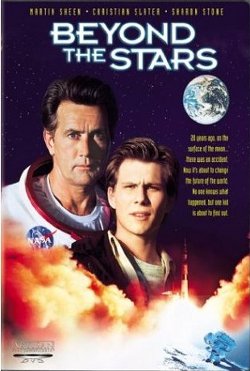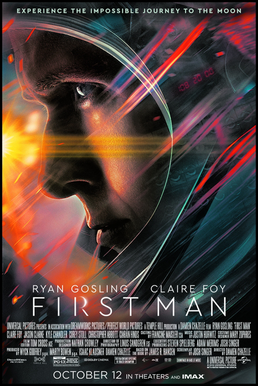
Apollo 8 was the first crewed spacecraft to leave low Earth orbit and the first human spaceflight to reach the Moon. The crew orbited the Moon ten times without landing, and then departed safely back to Earth. These three astronauts—Frank Borman, James Lovell, and William Anders—were the first humans to witness and photograph the far side of the Moon and an Earthrise.

The Apollo program, also known as Project Apollo, was the United States human spaceflight program carried out by the National Aeronautics and Space Administration (NASA), which succeeded in preparing and landing the first men on the Moon from 1968 to 1972. It was first conceived in 1960 during President Dwight D. Eisenhower's administration as a three-person spacecraft to follow the one-person Project Mercury, which put the first Americans in space. Apollo was later dedicated to President John F. Kennedy's national goal for the 1960s of "landing a man on the Moon and returning him safely to the Earth" in an address to Congress on May 25, 1961. It was the third US human spaceflight program to fly, preceded by the two-person Project Gemini conceived in 1961 to extend spaceflight capability in support of Apollo.

Apollo 13 was the seventh crewed mission in the Apollo space program and the third meant to land on the Moon. The craft was launched from Kennedy Space Center on April 11, 1970, but the lunar landing was aborted after an oxygen tank in the service module (SM) ruptured two days into the mission, disabling its electrical and life-support system. The crew, supported by backup systems on the lunar module (LM), instead looped around the Moon in a circumlunar trajectory and returned safely to Earth on April 17. The mission was commanded by Jim Lovell, with Jack Swigert as command module (CM) pilot and Fred Haise as lunar module (LM) pilot. Swigert was a late replacement for Ken Mattingly, who was grounded after exposure to rubella.

Apollo 15 was the ninth crewed mission in the United States' Apollo program and the fourth to land on the Moon. It was the first J mission, with a longer stay on the Moon and a greater focus on science than earlier landings. Apollo 15 saw the first use of the Lunar Roving Vehicle.

Apollo 16 was the tenth crewed mission in the United States Apollo space program, administered by NASA, and the fifth and penultimate to land on the Moon. It was the second of Apollo's "J missions", with an extended stay on the lunar surface, a focus on science, and the use of the Lunar Roving Vehicle (LRV). The landing and exploration were in the Descartes Highlands, a site chosen because some scientists expected it to be an area formed by volcanic action, though this proved not to be the case.

Luna 15 was a robotic space mission of the Soviet Luna programme, that was in lunar orbit together with the Apollo 11 Command module Columbia.

James Edmund Caan was an American actor. He came to prominence playing Sonny Corleone in The Godfather (1972) – a performance that earned him Academy Award and Golden Globe nominations for Best Supporting Actor. He reprised his role in The Godfather Part II (1974). He received a motion-picture star on the Hollywood Walk of Fame in 1978.

From the Earth to the Moon is a twelve-part 1998 HBO television miniseries co-produced by Ron Howard, Brian Grazer, Tom Hanks and Michael Bostick. In docudrama format, it tells the story of the Apollo program during the 1960s and early 1970s. Largely based on Andrew Chaikin's 1994 book, A Man on the Moon, the series is known for its accurate telling of the story of Apollo and the special effects under visual director Ernest D. Farino. The series takes its title from, but is not based upon, Jules Verne's 1865 science fiction novel From the Earth to the Moon.
The Apollo Applications Program (AAP) was created as early as 1966 by NASA headquarters to develop science-based human spaceflight missions using hardware developed for the Apollo program. AAP was the ultimate development of a number of official and unofficial Apollo follow-on projects studied at various NASA labs. However, the AAP's ambitious initial plans became an early casualty when the Johnson Administration declined to support it adequately, partly in order to implement its Great Society set of domestic programs while remaining within a $100 billion budget. Thus, Fiscal Year 1967 ultimately allocated $80 million to the AAP, compared to NASA's preliminary estimates of $450 million necessary to fund a full-scale AAP program for that year, with over $1 billion being required for FY 1968. The AAP eventually led to Skylab, which absorbed much of what had been developed under Apollo Applications.

Marooned is a 1969 American science fiction film directed by John Sturges and starring Gregory Peck, Richard Crenna, David Janssen, James Franciscus and Gene Hackman about three astronauts who are trapped and slowly suffocating in space. It was based on the 1964 novel Marooned by Martin Caidin. While the original novel was based on the single-pilot Project Mercury, the film depicted an Apollo command and service module with three astronauts and a space station resembling Skylab. Caidin acted as technical adviser and updated the novel, incorporating appropriate material from the original version.
Salvage 1 is an American science fiction series that was broadcast for 16 episodes on ABC during 1979. The series was based on the pilot film, Salvage, broadcast in early 1979.

For All Mankind is a 1989 documentary film made of original footage from NASA's Apollo program, which successfully prepared and landed the first humans on the Moon from 1968 to 1972. It was directed by Al Reinert, with music by Brian Eno. The film, consisting of footage from Apollo 7 through Apollo 17, was assembled to depict what seems like a single trip to the Moon, highlighting the beauty and otherworldliness of the images by only using audio from the interviews Reinert conducted with Apollo crew members.

Apollo 11 was the first human spaceflight to land on the Moon. The 1969 mission's wide effect on popular culture has resulted in numerous portrayals of Apollo 11 and its crew, Neil Armstrong, Buzz Aldrin, and Michael Collins.

Fly Me to the Moon is a 2008 animated science fiction comedy film about three flies who stowaway aboard Apollo 11 and travel to the Moon. It was directed by Ben Stassen and written by Domonic Paris. The film was released in digital 3-D in Belgium on 30 January 2008, and in the US and Canada on 15 August. The film was also released in IMAX 3-D in the US and Canada on 8 August. The film serves as a fictionalized retelling of the 1969 Apollo 11 mission by incorporating a story of three young flies that stow away on the rocket to fulfil their dream of going up to the moon, while their families take on a group of Soviet flies who try to sabotage the mission.
Henry Hunt Searls was an American author and screenwriter. His novels included The Crowded Sky (1960), which was adapted as the 1960 movie of the same name; The Pilgrim Project (1964), which was adapted as the 1968 movie Countdown; and The Penetrators. Searls also wrote the novelizations for the movies Jaws 2 (1978) featuring Roy Scheider and Murray Hamilton, and Jaws: The Revenge (1987) featuring Michael Caine and Lorraine Gary.

Beyond the Stars is a 1989 American science-fiction drama film written and directed by David Saperstein and starred Martin Sheen, Christian Slater, Sharon Stone, Olivia d'Abo, and F. Murray Abraham. The film was originally titled Personal Choice. It was never released in theaters.

First Man is a 2018 American biographical drama film directed by Damien Chazelle from a screenplay by Josh Singer, based on the 2005 book of the same name by James R. Hansen. The film stars Ryan Gosling as Neil Armstrong, alongside Claire Foy, Jason Clarke, Kyle Chandler, Corey Stoll, Christopher Abbott, and Ciarán Hinds, and follows the years leading up to the Apollo 11 mission to the Moon in 1969.

Capture the Flag is a 2015 Spanish animated science-fiction adventure comedy film directed by Enrique Gato and written by Patxi Amezcua. Produced by 4 Cats Pictures and animated by Lightbox Entertainment, the film was distributed worldwide by Paramount Pictures, which was a milestone for Spanish cinema, as this was the first time a major Hollywood studio acquired and agreed to distribute two Spanish animated films worldwide, with the other one being Tad the Lost Explorer and the Secret of King Midas. The film takes place in the present alternate times of the year 2015, and the storyline is about Mike Goldwing, a 12-year-old surfer who embarks on a journey with his friends to disrupt a billionaire's plan to destroy the American flag planted on the Moon.















